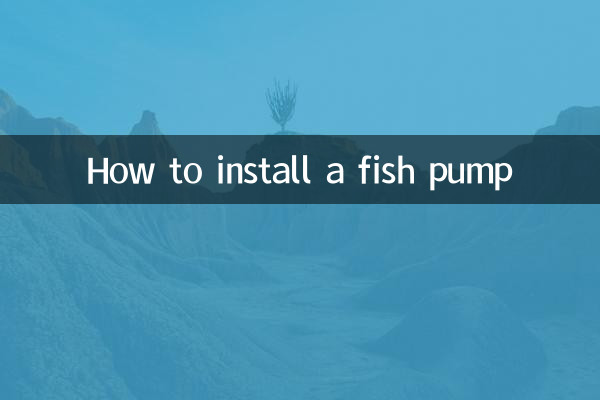How to install a fish pump
Among the hot topics in the past 10 days, aquarium enthusiasts have shown great concern about the installation method of fish pumps. Fish pumps are key equipment for maintaining water quality and oxygen supply in fish tanks. Correct installation can not only extend the life of the equipment, but also ensure the health of the fish. This article will introduce in detail the installation steps, precautions and FAQs of the fish pump to help you complete the installation easily.
1. Preparations before installation of fish pump

Before installing a fish pump, you need to prepare the following tools and materials:
| Tools/Materials | use |
|---|---|
| fish pump | Core equipment for oxygenating or circulating water |
| hose | Connect the fish pump to the fish tank |
| Suction cup or retaining clip | Fixed fish pump and hose |
| Scissors | Trim hose length |
| power adapter | Powering fish farming pumps |
2. Fish pump installation steps
1.Choose the right location: The fish pump should be installed in a stable, dry place near the fish tank, away from direct sunlight or humid environment.
2.Connecting hose: Connect one end of the hose to the water outlet of the fish pump, and extend the other end into the fish tank. Make sure the hose is the right length and avoid being too long or too short.
3.Fixed fish pump: Use suction cups or fixing clips to fix the fish pump to the edge of the fish tank or a nearby wall to ensure that the equipment is stable.
4.Check power supply: Plug the power adapter of the fish pump into the socket and ensure that the power voltage is consistent with the equipment requirements.
5.test run: Turn on the fish pump, observe whether the water flow and oxygen output are normal, and make timely adjustments if there are any abnormalities.
3. Installation precautions
| Things to note | illustrate |
|---|---|
| avoid idling | If the fish pump is operated without water, the equipment will be damaged. |
| Regular cleaning | Hoses and pump bodies need to be cleaned regularly to prevent clogging. |
| Power safety | Make sure the power cord is away from water sources to prevent leakage |
| Noise control | Choose a low-noise pump or add shock-absorbing pads |
4. Frequently Asked Questions
1.What should I do if the fish pump is noisy?: Check whether the pump body is firmly fixed, or add shock-absorbing pads to reduce vibration.
2.Why does the fish pump not pump water?: It may be that the hose is clogged or the pump body is faulty, and the parts need to be cleaned or replaced.
3.Does the fish pump need to be turned on all the time?: It is recommended to operate 24 hours a day to ensure stable water quality and oxygen supply.
5. Summary
Although the installation of a fish pump is simple, the details determine success or failure. With the above steps and precautions, you can easily complete the installation and provide a healthy living environment for your fish. If you have any other questions, please leave a message in the comment area to discuss!

check the details

check the details